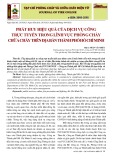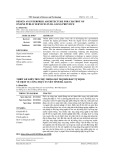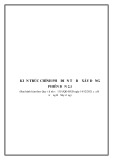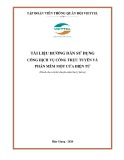
VNU Journal of Economics and Business, Vol. 4, No. 6 (2024) 83-93
83
Original Article
Essential factors driving the adoption of online public services
among Hanoi’s citizens
Pham Ngoc Huong Quynh1,*, Nguyen Bich Ha2
1VNU University of Economics and Business
No. 144, Xuan Thuy Road, Cau Giay District, Hanoi, Vietnam
2Dai Nam University
Phu Lam, Ha Dong, Hanoi, Vietnam
Received: October 09, 2024
Revised: December 06, 2024; Accepted: December 25, 2024
Abstract: This study investigates the factors influencing citizens’ intention to use online public
services (OPS), focusing on perceived usefulness, trust in security, convenience, ease of use, and
technological accessibility. Using a survey of 334 people in Hanoi and the PLS-SEM model, the
study analyzes the impact of these factors on user intention through a series of empirical tests. The
results reveal that perceived usefulness is the strongest predictor of user intention, supported by
significant positive effects from trust in security and perceived convenience. Perceived ease of use
shows a positive but less pronounced impact, while technological accessibility has a more minor yet
significant effect. These findings align with established theories in technology adoption and provide
practical implications for policymakers and service providers. To enhance the adoption of OPS, it is
crucial to communicate the benefits of these services, implement robust security measures, and
improve user convenience. Addressing technological accessibility is also important but should be
complemented by efforts to strengthen other critical factors. This study offers valuable insights for
designing and implementing effective OPS.
Keywords: Online public services, perceived usefulness, trust in security, perceived convenience,
perceived ease of use. *
1. Introduction
The digital transformation wave has
significantly reshaped public administration
globally, with OPS emerging as a cornerstone of
modern e-governance (Hooda & Singla, 2018;
Ma & Wu, 2020; Piehler et al., 2016). By
________
* Corresponding author
E-mail address: quynhphamnh@vnu.edu.vn
https://doi.org/10.57110/vnu-jeb.v4i6.341
Copyright © 2024 The author(s)
Licensing: This article is published under a CC BY-NC 4.0 license.
enabling citizens to access government services
electronically, OPS promises enhanced
efficiency, transparency, and accessibility,
contributing to more responsive and inclusive
governance (Alkraiji, 2020; Kwilinski et al.,
2024). In Vietnam, particularly in Hanoi, the
capital city and a central urban hub, the
VNU Journal of Economics and Business
Journal homepage: https://jeb.ueb.edu.vn

P.N.H. Quynh, N.B. Ha / VNU Journal of Economics and Business, Vol. 4, No. 6 (2024) 83-93
84
government has vigorously promoted OPS as
part of its broader digital transformation strategy
(Nguyen et al., 2023; Nguyen et al., 2024).
Despite these efforts, the adoption of OPS
among Hanoi’s citizens has been uneven, with
some segments of the population readily
embracing these services while others remain
hesitant (Nguyen et al., 2020). This variation in
adoption rates underscores the need for a deeper
understanding of the factors influencing citizens’
engagement with OPS.
In the context of Vietnam, while there has
been research on e-government adoption
(Nguyen et al., 2020; Nguyen et al., 2023)in the
context of Vietnam, there remains a noticeable
gap in the literature explicitly addressing OPS
adoption among citizens in Hanoi. Existing
studies focus broadly on e-government
initiatives without delving into the unique
challenges and opportunities associated with
OPS in the Hanoi metropolitan area. Due to its
rapid urbanization and the interplay between
modern administrative practices and traditional
bureaucratic structures, Hanoi presents a distinct
case. This urban-rural dynamic and cultural
factors unique to Hanoi create a complex
environment for the effective rollout and
acceptance of OPS.
The absence of detailed research focusing on
Hanoi means a limited understanding of how
specific local factors, such as varying levels of
digital literacy, trust in local government, and
socioeconomic disparities, affect OPS adoption
and utilization. As Hanoi continues to modernize
and integrate digital technologies into public
services, addressing this research gap is crucial
for developing targeted strategies that cater to
the specific needs and conditions of the city’s
population.
This study aims to fill this gap by exploring
the essential factors that drive the adoption of
OPS among Hanoi’s citizens. This research will
identify and analyze the socio-demographic,
psychological, and technological factors
influencing citizens' willingness and ability to
use online public platforms. In doing so, it aims
to provide insights that are relevant to Hanoi and
applicable to other urban centers in Vietnam and
similar developing countries. The study’s
findings will contribute to the existing body of
knowledge on E-government adoption and offer
practical recommendations for policymakers and
practitioners aiming to enhance OPS uptake.
2. Literature review
2.1. Ground theories
The TAM Model, proposed by Davis (1989),
has been widely used to understand technology
adoption. According to TAM, when users find
technology easy to use and believe it will benefit
them, their intention to use it increases. Recent
studies have applied TAM to various online
services and found that ease of use and
usefulness significantly impact users’ intentions
(Hooda Nandal & Singla, 2018; Wu & Chen,
2005). Furthermore, Ajzen’s (1991) TPB
extends the Theory of Reasoned Action by
incorporating perceived behavioral control,
attitudes, and subjective norms. In the context of
OPS, TPB can explain the impact of trust and
convenience on users’ intentions. Studies have
shown that trust in the security and reliability of
online services and perceived convenience are
significant predictors of users’ behavioral
intentions (Wu & Chen, 2005). In addition, Trust
and Perceived Risk Theory, as discussed by
Mayer et al. (1995), emphasizes that trust plays
a crucial role in online interactions. Trust in
online services’ security, privacy, and reliability
can significantly influence users’ willingness to
use these services. For OPS in Hanoi, trust in the
service providers and the overall system is
essential for increasing citizens’ engagement.
Studies have highlighted that perceived risk and
trust are critical factors affecting users' decisions
to adopt online services (Janssen et al., 2018;
Ventre & Kolbe, 2020).
2.2. Hypothesis development
H1: Perceived ease of use of OPS in Hanoi
increases citizens’ intention to use them.
The hypothesis states that the easier it is for
citizens in Hanoi to use OPS, the more likely
they are to adopt these services. Ease of use
refers to user-friendly, intuitive systems
requiring minimal effort to navigate and that are
free from technical issues. Based on the TAM by
Davis (1989), perceived ease of use significantly
influences technology adoption by reducing
mental effort and increasing user satisfaction.
Horst et al. (2007), confirm that systems

P.N.H. Quynh, N.B. Ha / VNU Journal of Economics and Business, Vol. 4, No. 6 (2024) 83-93
85
perceived as easy to use enhance user intention.
For OPS, simple interfaces and easy navigation
are crucial for engagement.
H2: The perceived usefulness of OPS in
Hanoi increases citizens’ intention to use them.
The hypothesis suggests that if citizens in
Hanoi perceive OPS as useful, they are more
likely to adopt them. Perceived usefulness refers
to the belief that using these services enhances
efficiency or quality of life, such as saving time
or improving access to resources. Rooted in the
TAM by Davis (1989), perceived usefulness is a
key factor influencing technology adoption,
often more impactful than ease of use. Studies,
including (Nguyen et al., 2024) show that
recognizing tangible benefits, like reducing
physical visits to government offices, increases
the likelihood of adopting OPS.
H3: Trust in the security and reliability of
OPS in Hanoi increases citizens’ intention to
use them.
The hypothesis posits that trust in the
security and reliability of OPS in Hanoi
positively influences citizens’ intention to use
these services. Trust is vital, as users must feel
assured about data protection and system
reliability. Rooted in trust theories, particularly
in e-commerce and online services, this concept
is supported by Hooda et al. (2022) and Horst et
al. (2007) who emphasize that secure and
consistently performing systems significantly
enhance user adoption. For public services
handling sensitive data, robust security and
reliable performance are crucial for building
trust and encouraging usage.
H4: Government support and promotion of
OPS in Hanoi increase citizens’ intention to
use them.
The hypothesis posits that increased
government support and promotion of OPS in
Hanoi enhances citizens’ intention to use these
services. This support includes campaigns,
training, and subsidies, making OPS more
accessible while addressing misconceptions.
Rooted in Rogers’ Diffusion of Innovations
theory (2003), government efforts are crucial for
fostering technology adoption by reducing risks
and providing necessary information. Research,
including studies by Chen et al. (2024) and
Nzaramyimana and Susanto (2019), confirms
that such initiatives boost awareness and usage
of online services, with campaigns and
incentives effectively decreasing resistance and
increasing adoption rates.
H5: Perceived convenience of accessing and
using OPS in Hanoi increases citizens’ intention
to use them.
The hypothesis suggests that the
convenience of accessing and using OPS in
Hanoi positively influences citizens’ intention to
use these services. Convenience, involving ease,
speed, and accessibility from any location or
time, reduces effort and enhances user adoption.
Rooted in the Theory of Reasoned Action
(TRA), this concept is supported by Kulal et al.
(2024) and Kumar et al. (2024) identifying
perceived convenience as a key factor in
technology adoption. Studies on mobile banking,
e-commerce, and online government services
confirm that higher convenience leads to greater
adoption rates.
H6: Technological accessibility, including
internet connectivity and device availability,
increases citizens’ intention to use OPS
in Hanoi.
The hypothesis asserts that technological
accessibility, such as reliable internet
connectivity and device availability,
significantly influences citizens’ intention to use
OPS in Hanoi. Studies by Kulal et al. (2024) and
Kumar et al. (2024) highlight the critical role of
technological resources in adopting new
technologies. Improved internet infrastructure
and device penetration are essential for increasing
OPS usage. In Hanoi, widespread, affordable
internet access and user-friendly devices are vital
to encouraging higher adoption rates.
The research model is derived from
analyzing key factors influencing citizens’
intention to use OPS in Hanoi. Each hypothesis
identifies a critical variable - such as perceived
ease of use, perceived usefulness, trust in
security, government support, convenience, and
technological accessibility - that impacts user
adoption. These factors are supported by
established theories like the TAM, TPB, and
other theories. By integrating these variables, the
model provides a structured framework that
explains how these elements interact to shape
citizens’ intention to adopt OPS. The research
model is proposed as shown in Figure 1.

VNU Journal of Economics and Business, Vol. 4, No. 6 (2024) 83-93
86
Figure 1: Research model
Source: Author’s proposal.
3. Research methodology
3.1. Measurement of research variables
Table 1: Proposed scale table
Factors
Coding
Observed variables
Sources
Perceived ease
of use (PEU)
PEU1
The OPS are easy to access.
Davis (1989);
Nguyen et al.
(2024)
PEU2
The interface of OPS is user-friendly.
PEU3
I find it simple to use OPS without needing help.
Perceived
usefulness
(PUS)
PUS1
Using OPS improves my efficiency in handling
administrative tasks.
Chen &
Aklikokou
(2020), Nguyen
et al. (2024)
PUS2
OPS provide clear benefits compared to traditional methods.
PUS3
I find that OPS increase my productivity.
Trust in security
and reliability
(TSR)
TSR1
I feel confident that my personal information is secure when
using OPS.
Hooda et al.
(2022), Khan et
al. (2021), Ventre
& Kolbe (2020)
TSR2
OPS are reliable and perform consistently well.
TSR3
I trust that OPS will function correctly and protect my data.
Government
support and
promotion
(GSP)
GSP1
The government actively promotes the use of OPS.
Alkraiji (2020),
Nguyen et al.
(2020)
GSP2
Government provides adequate support and resources to
help citizens use OPS.
GSP3
There are effective awareness campaigns about the benefits
of OPS.
Perceived
convenience
(PEC)
PEC1
OPS are easily accessible from any location.
Alalwan et al.
(2018), Nguyen
et al. (2020)
PEC2
Using OPS saves me time compared to in-person visits.
PEC3
The process of using OPS is convenient and hassle-free.
Technological
accessibility
(TAC)
TAC1
I have reliable internet access to use OPS.
Bertot et al.
(2012),
Moghaddam &
Khatoon-Abadi
(2013)
TAC2
I have access to the necessary devices to use OPS.
TAC3
Technical support is available if I encounter problems with
accessing OPS.
Intention to use
OPS (IUS)
IUS1
I intend to use OPS in the near future.
Aljazzaf et al.
(2020), Piehler
et al. (2016),
Wirtz et al.
(2020)
IUS2
I plan to regularly use OPS.
IUS3
I am likely to use OPS whenever I need them.
IUS4
I foresee myself using OPS more frequently in the coming
months.
Source: Author’s review.
Perceived ease of use (PEU)
Perceived usefulness (PUS)
Trust in the security (TSR)
Intention to use online
public services (IUS)
Government support and promotion (GSP)
Perceived convenience (PEC)
Technological accessibility (TAC)

P.N.H. Quynh, N.B. Ha / VNU Journal of Economics and Business, Vol. 4, No. 6 (2024) 83-93
87
3.2. Research design and data collection
This study utilizes a quantitative research
design to systematically investigate the factors
that influence the intention of citizens in Hanoi
to use OPS. The core of the research involves a
structured survey crafted to capture detailed data
on several vital constructs: perceived usefulness,
trust in security, perceived convenience,
perceived ease of use, and technological
accessibility. By focusing on these constructs,
the study seeks to understand how each impacts
the intention to engage with OPS. The primary
objective is to identify and measure the strength
and significance of these relationships through
rigorous statistical analysis.
The data collection process involved
administering an online survey to 334
respondents. The decision to use an online
distribution method was driven by the need to
reach a broad and diverse audience, ensuring that
the sample accurately reflects the general
population. The survey was carefully designed to
capture various demographic information,
including age, gender, family income, and
occupation. This demographic segmentation
allows for a comprehensive analysis of how
different population groups perceive and are
influenced by OPS.
3.3. Data analysis method
Data analysis for this study was conducted
using Partial Least Squares Structural Equation
Modeling (PLS-SEM), a method suited for
evaluating complex relationships between latent
constructs. The model was specified with both
measurement and structural components. The
measurement model was assessed for reliability
and validity using Composite Reliability,
Cronbach’s Alpha, and Average Variance
Extracted (AVE), all meeting acceptable
thresholds. Discriminant validity was confirmed
through the Fornell-Larcker criteria. The
structural model analysis involved examining
path coefficients, T statistics, and P values to test
the significance of relationships. The results
indicated that perceived usefulness had the most
substantial impact on the intention to use OPS,
followed by trust in security, perceived
convenience, perceived ease of use, and
technological accessibility, with all relationships
being statistically significant. Data processing
was performed using SmartPLS software,
ensuring robust insights into the factors
influencing user intention.
4. Research results
4.1. Characteristics of the research sample
The demographic profile of the survey
respondents (Table 2) shows a diverse and
predominantly middle-aged group, with a slight
majority of male participants. Most respondents
fall into lower to middle-income brackets, and
their occupations range widely, with office staff,
business owners, students, and workers being the
most represented. This distribution suggests that
the survey captures a broad cross-section of the
population, reflecting a variety of economic and
professional backgrounds.
Table 2: Demographic profile of respondents
Characteristics
Responses
Percent
Age
Below 22
40
12.0
22-34
98
29.3
35-55
131
39.2
56 and above
65
19.5
Gender
Male
189
56.6
Female
145
43.4
Family
income per
person
Below 7 million VND
138
41.3
From 7-15 million VND
132
39.5
Higher 15 million VND
64
19.2
Occupation
Students
71
21.3
Office staff
90
26.9
Workers
67
20.1
Business owners
81
24.3
Others
25
7.5
Total
334
100.0
Source: Author’s survey data.


























